How to install an air conditioner in a plastic window: technology secrets and installation instructions
A miniature, productive, easy-to-use window climate system is an excellent solution for small apartments, small offices, and country houses. Its important advantage is its monoblock nature. Thanks to it, installing an air conditioner in a window is done in the simplest way.
The location of all functional parts in one housing makes it possible to avoid laying pipelines. The lightness and elementary connection diagram allows you to do all the work yourself. However, for an impeccable result, you need to know how to correctly perform installation work.
You will find everything about the rules and procedure for the location, fixation and connection of window air conditioning equipment in our article. We will talk about the rules and technological subtleties. We’ll show you how to successfully choose a place for the unit.
The content of the article:
Briefly about the features of a window air conditioner
The window climate control unit does not have to be installed specifically in a wooden window frame or plastic double-glazed window. This air conditioner can be perfectly mounted into a wall or door leading to the garden. But windows are rightfully considered the most suitable place for it, given the design features.
In window climate systems, the outer part is placed together with the compressor unit in one housing. Therefore, as we have already written, there is no need to connect them with pipes and drill walls for these purposes, lay furrows in them for route devices. In addition, this design eliminates freon leaks that occur due to depressurization of working routes.
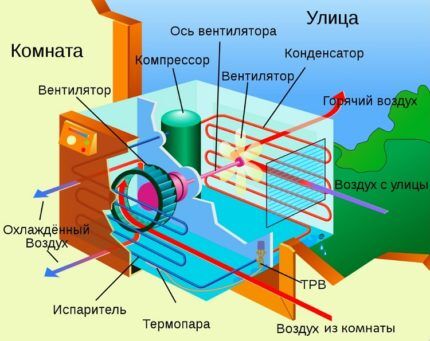
But we note right away that placing both functional components in one housing does not eliminate the need to install part of the system outside so that the equipment can freely capture air from the street for processing and supply of cold or heat (depending on the season) to the room being processed.
In order for air capture to be complete, virtually a third of the device or even half of it must be located outside the enclosing structure. That is, the installation must be done so that the air intake grille is completely behind the wall or window frame. As a result, the weighty part of the body ends up on the outside.

Since it is not possible to completely install an air conditioner on the windowsill of a plastic window, various supporting structures are built for its outer part. Their task is to accept the load of equipment, albeit not heavy, but still having quite a serious weight.
Read also: How to adjust a plastic window for winter or summer.
Wall brackets secured with anchor bolts in the wall are most often used as supporting structures. Less commonly, to hold climate control units, platforms are built that rest on the window sill or on the same brackets. Even more rarely, the window sill is built towards the street.
It is not recommended to install a window air conditioner in a window or other structure that is directly illuminated by the sun. Electrical components and plastic parts are strictly prohibited from heating up. If there is no other way out, then it is necessary to arrange a canopy for the equipment, excluding exposure to rays, and at the same time, rain and snow.
Choosing the best location
Heating should also be avoided indoors. To properly install a window air conditioner in a room, you need to choose a place away from stoves, fireplaces, boilers, all types of radiators, boilers and even refrigerators. Due to their influence, the climate system will not work correctly.
The equipment must be protected from active exposure to water. For this reason, you should not place the air conditioner near the kitchen sink or bathtub.If water penetrates into the housing or large amounts of steam settle on the internal electrical components, it should be immediately disconnected from the power supply and have a technician inspect it.
Only a certified repairman will be able to determine whether the functional elements of the window equipment have been damaged by water that has penetrated under the frame. And also, in order to eliminate the slightest possibility of exposure to water, it is prohibited to place a mini-climate system in bathrooms, bath buildings, showers, laundries, and swimming pools.
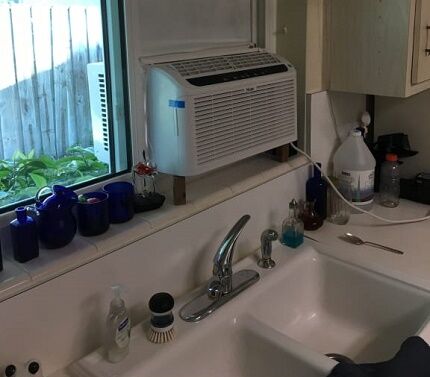
To eliminate the influence of electromagnetic waves on the operation of a window air conditioner, it should not be installed next to electrical equipment of any type. Even a radio receiver can disrupt the workflow. The permissible distance to electrical appliances is specified by the manufacturer in the product manual; it is usually 1 m.
It is not recommended to connect the climate system to the network via an extension cord. The power point must be located relative to the housing so that the cord is long enough for direct connection. On the other hand, it is impossible for there to be less than 50 cm between the electrical installation product and the housing.
It is also prohibited to locate devices that are potential sources of gas leakage near the air conditioner. This category includes boilers, gas water heaters such as columns, gas convectors, stoves and cylinders filled with blue fuel.
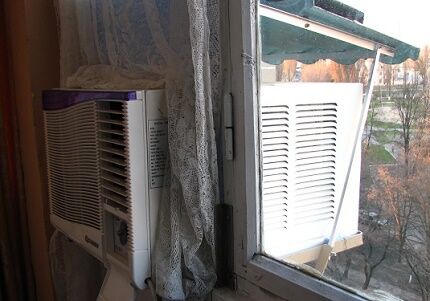
In order to ensure a stable inflow and outflow of air in the volume specified by the manufacturer, all grilles intended for air intake and outlet must be completely open. Owners must have easy access to service the unit. And the service center technicians need to be provided with the opportunity for inspection.
A window air conditioner is absolutely not suitable for installation in building mixture warehouses and in apartments where building materials for major repairs are stored. It should not be installed in boiler rooms. It is not suitable for the kitchen of a catering establishment either.
Requirements for installing an air conditioner
To eliminate the risk of electric shock, air conditioning equipment must be grounded. To do this, use a socket with the appropriate contact. Do not ground to a telephone wire or water supply network.
Familiarize yourself with the rules for choosing a location for installing an outlet that powers an air conditioner. next article, which is worth reading for all real and potential owners of a window climate system.
To power the window air conditioner, you will need a separate line with a circuit breaker installed at its input. It is better to lay the branch from the electrical panel, and not from the distribution box.
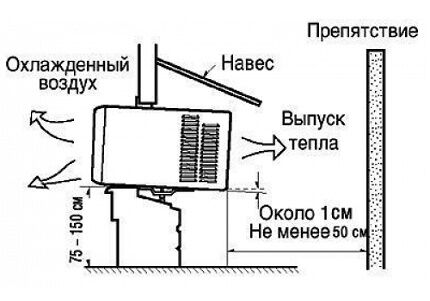
The mono-air conditioner must be located at a distance of at least 75 cm, but not more than 150 cm, from the floor plane. There must be at least 0.5 m from the rear panel of the unit to the nearest obstacle in the form of a wall or similar structure. This is necessary to ensure free movement air flow.
At the same time, there should be no gaps around the perimeter of the housing. Their absence is achieved by installing the curtains included in the kit. All types of sealants and sealant are used, in short, everything that can be used to eliminate gaps with drafts.

It is also necessary to ensure that the building slopes towards the street. The housing must be tilted so that the inner edge of the housing rises above the outer edge by about 1 cm. This tilt is necessary so that the moisture condensing on the housing flows back to the street, and does not drip into the room and does not moisten building structures with a seal.
Sequence of installation technology
Before installing a mini climate control system, you should carefully study the instructions that a caring manufacturer must include with their products. It describes in detail all the actions, in the implementation of which there may be some differences, but in general everything is done in a standard manner.
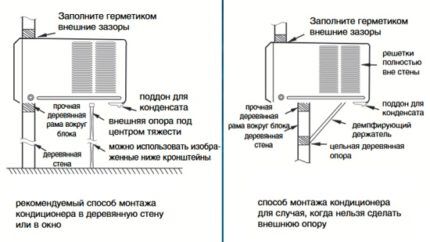
The entire cycle of work includes a number of successive stages, these are:
- Arrangement of the opening, selected with a hammer drill, glass cutter, or grinder, the dimensions of which correspond to the dimensions of the frame included in the package.
- Frame fixation. It is first unscrewed from the air conditioner body. Then they are placed in the opening so that the fit along the bottom line is as tight as possible, and a minimum gap remains at the top. After attaching the frame, the side gaps are filled with sealant from the street side.
- Installing the air conditioner in a fixed housing. Before doing this, you should check whether the porous sponge seal laid around the perimeter of the frame is damaged.
The hole for installing the frame in the wall or sash of a wooden door is selected in accordance with its dimensions. It is made a little larger so that it remains possible to freely insert this frame into the opening. The frame should fit tightly into the seat.
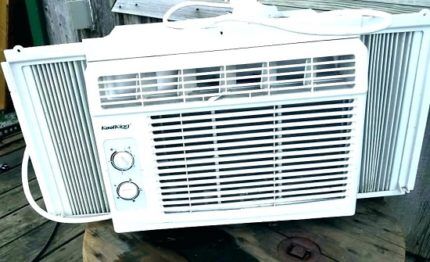
With plastic windows, everything is a little more complicated - you need to cut out the entire glass from the sash, focusing on the height of the air conditioner. As with wall mounting, there should also be a slight gap at the top. It is filled with sealant.
Buyers of window models do not need to think about how best to reduce the window frames to install an air conditioner. All points are provided by the manufacturer. The side space is filled with sealed curtains that move along guides according to the “accordion” principle.
Mounting the air conditioner in the frame
Let's look at the process of installing a window air conditioner using General Climate window climate control systems as an example. These monoblocks are actively in demand among our compatriots and are suitable for use in our conditions. Everyone who has tested their work in practice is satisfied with the performance and quality of cooling.
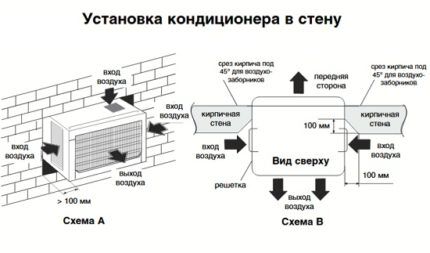
We will fix the air conditioner in the housing in the following order:
- Carefully, trying not to displace the seal located inside, we immerse the air conditioner into the previously installed and secured frame. We carefully introduce the unit until we “rest” against the rear wall of the structure.
- We connect the cable to the socket on the air conditioner body intended for connecting the power supply line. We wind up the excess cord, secure it with tape and place it under the unit.
- We screw the fasteners into the lower “sleds” of the frame.
- We remove the front panel of the window air conditioner from the packaging, place it in its proper place and secure it.
- We start the air conditioner and check whether the housing vibrates during operation of the system.
If vibration has been detected, it must be eliminated by eliminating small gaps with a sealant, and large ones with wooden wedges. If it cannot be eliminated, all the work will have to be redone by dismantling the equipment. Once again you will need to check the geometry of the opening and, if necessary, correct it in a way that depends on the wall material.

If you make mistakes in forming an opening in a plastic window, the hassle will be much greater. The contractor will have to completely change the light-conducting element and the upper jumper to which the frame was attached. However, in most cases, the matter can be resolved simply by filling the gaps with a sealant or sealing compound.
Finally, a tray is placed under the mini air conditioner into which the condensate drains. If necessary, a tube is connected to assemble it. It all depends on how the owners are going to maintain the equipment and how it is more convenient for them.
The following photo selection will clearly show you the steps of installing window climate control equipment:
If the design of a plastic window is not initially designed for the installation of a monoblock air conditioner, all glass is removed from the sash planned for installation. Then proceed like this:
From the inside, the joints can be sealed with tape using a budget option.However, it is better to cover it with a plastic molding, baseboard or bath corner - it’s both more beautiful and reliable. To protect against possible damage, exposure to water and dust above the protruding part of the window air conditioner install a visor, the features of the device of which will be introduced in our article.
Troubleshooting yourself
If your air conditioner suddenly stops cooling the air in the room entrusted to it, you can independently determine the cause of the problem:
- Does not work. The reason may be a lack of power supply. Occurs due to a damaged plug or cord, a blown fuse, or a lack of voltage in the electrical network.
- Poor cooling. Air flow is obstructed by a dirty filter, an obstruction, or a nearby heat-generating appliance.
- Doesn't heat well. The heat exchanger located outside is frozen, which prevents air circulation.
A normally operating window air conditioner will make a barely audible click when the thermostat starts and stops, and after the compressor is turned off, the fan will still run for a short period of time.
Conclusions and useful video on the topic
The following video will introduce you to the features of installing a used window air conditioner for temporary use at the dacha:
Knowing the technology for installing a monoblock air conditioner in a window or other structure is useful for both independent home craftsmen and customers of installer services. The former will be able to independently perform all operations in an order that will ensure a reliable installation. The latter will competently monitor the actions of the installers, who, unfortunately, do not always themselves know how best to do it.
Share your personal experience from installing mini air conditioners in windows.Do you have useful information on the topic of the article that you need to communicate to visitors? Please leave comments in the block below, ask questions and post photographs of the work steps.



